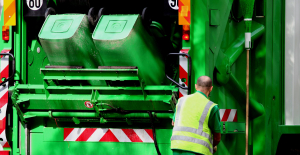the Ongoing Finnish study according to a part of the Finnish mothers get caffeine over the recommended limits.
Fetal caffeine exposure is thought to be particularly large finns expect to have, because the coffee consumed in Finland more than anywhere else in the world.
the European recommended limit for safe intake of caffeine for pregnant women is less than 200 milligrams daily, or about 2-3 cups of filter coffee a day.
the Same recommendation is valid also in Finland.
scientists have sorted out the baby of caffeine exposure with the new method, which caffeine accumulation measured in neonatal hair.
caffeine exposure is seen in neonatal hair of several months of pregnancy period, says doctoral student Lauri Uusitalo .
He is with Kuopio university hospital in mission KuBiCo study, which has now developed a new method of intrauterine exposure to measure, together with the university of Eastern Finland department of pharmacy.
the New method allows the newborn's hair can be measured through the mother has become prone to doing: caffeine but also drugs, intoxicants and plastic pehmentäjiä, i.e. phthalates. MostphotosUusitalo, caffeine long-term effects on the health of the baby has been studied so far in the Finnish population very little.
the Previous screen caffeine drawbacks has been based on the mother the nutrition surveys and the fetus obtained by the actual exposure not known.
after the Birth to take the hair sample the advantage is that it is seen in the fetus-term caffeine intake over the last month of pregnancy period.
When my mom drinking coffee, it contains caffeine pass into the mother's bloodstream to the fetus. Fetal hair starts to grow around mid-pregnancy, when the blood flow of the caffeine is transferred to the growing hair and the uptake is measured after birth.
Caffeine passes through the placentaPregnant women ingested caffeine is thought to high doses to cause the resulting children's health.
Uusitalo, a high dose is considered the world more than 400 to 600 milligrams of caffeine a day.
xanthine compounds include caffeine passes through the placenta and not the fetus can't handle the caffeine effectively.
a Great caffeine exposure can previous international studies, join, inter alia, premature birth risk and the fetus small press of balance.
Copious amounts of coffee and cola beverages intake is according to studies, have been common also among children, overweight, learning difficulties and cancers such as leukemia and rare aivokasvaimiin. Links, however, are unclear and require more research.
hidden caffeine is also in chocolatethe Study involved 2900:to the mother up to 44 percent got the rest of the pregnancy nutrition questionnaire on the basis of caffeine over the recommended limit. In addition, 300 of the newborn hiusnäytteistä measured caffeine intake suggests that mothers are rated the caffeine I can get it done on the low side.
the Study measured children caffeine low concentrations, even in pregnancies where mothers indicated that they received caffeine at all.
Uusitalo, may be, that the mother of the caffeine is hidden caffeine, which can, for example, chocolate.
Caffeine occurs naturally in many foods and beverages, such as coffee and tea.
Mother has been perhaps the most difficult to identify having used caffeine-containing products.
according to the survey, 80% of mothers from getting the caffeine however coffee.
re-born recipient of the double readersEspecially re-born recipient of the caffeine intake as well as a children's hair measured caffeine was almost double that of the first confinement compared to.
Uusitalo, according to the results, it can be also concluded that the re-born recipient of the caffeine filtration placenta to the fetus is easier than the first.
– however, This requires further investigation.
next, the birth mother received caffeine in particular kolajuomista and chocolate. Again, the birth mother again drank to the researchers surprise, the two times higher doses of energy drinks.
why caffeine sources are different for first-time mothers and again give birth between not yet known.
Especially in the re-confinement appear according to the study, get caffeine over the recommended amount. Mostphotos caffeine components of ADHD?the aim of the Study is in the future to examine caffeine effects on pregnancy progression and the health of the child, but also to clarify the pregnancy diet recommendations.
Next, the researchers plan to figure out how to caffeine exposure affect the child's early behavior, such as sleeping and anxiety.
we Investigated whether newborns noticeable withdrawal symptoms much caffeine other central nervous system active compounds. Or is caffeine the supply connection, for example, ADHD-type disorders.
Uusitalo, according to the majority of caffeine intake, potential adverse effects should be taken seriously, but also remember caffeine the benefits.
– It is arguably also a huge benefit. For example, in the icu of caffeine is used the fact that the baby's breathing activate would work more efficiently.
the Future could be explored, for example, can the mother enjoyed by the caffeine affects premature babies born with breathing.
Drugs and päihteetkin viewsnewborn's hair can be measured also in the other through the mother has become prone to doing: nutrients, medications and drugs, air pollution, and other environmental compounds.
studies of newborns hiusnäytteistä found, inter alia, drugs and the environment of the mother's food or the breathing air through the of the hormone häiriköiksi, such as plastics plasticizers.
Uusitalo, according to the method can also be measured in the fetus early in the stress hormone levels.
the stress hormone cortisol increase, for example, anxiety or depression.
– It gives an opportunity to assess the fetal long-term cortisol levels and stress to the environment such as maternal stress effect.
so far, the methods it is possible to use only for research use. Method expensive because of the clinical health care use cases of pregnancy and childbirth related not to Uusitalo are in sight.

 Poland, big winner of European enlargement
Poland, big winner of European enlargement In Israel, step-by-step negotiations for a ceasefire in the Gaza Strip
In Israel, step-by-step negotiations for a ceasefire in the Gaza Strip BBVA ADRs fall almost 2% on Wall Street
BBVA ADRs fall almost 2% on Wall Street Ukraine has lost 10 million inhabitants since 2001... and could lose as many by 2050
Ukraine has lost 10 million inhabitants since 2001... and could lose as many by 2050 Sánchez cancels his agenda and considers resigning: "I need to stop and reflect"
Sánchez cancels his agenda and considers resigning: "I need to stop and reflect" The Federal Committee of the PSOE interrupts the event to take to the streets with the militants
The Federal Committee of the PSOE interrupts the event to take to the streets with the militants Repsol: "We want to lead generative AI to guarantee its benefits and avoid risks"
Repsol: "We want to lead generative AI to guarantee its benefits and avoid risks" Osteoarthritis: an innovation to improve its management
Osteoarthritis: an innovation to improve its management Ukraine gets a spokesperson generated by artificial intelligence
Ukraine gets a spokesperson generated by artificial intelligence The French will take advantage of the May bridges to explore France
The French will take advantage of the May bridges to explore France Organic flour contaminated by a recalled toxic plant
Organic flour contaminated by a recalled toxic plant 2024 Olympics: Parisian garbage collectors have filed a strike notice
2024 Olympics: Parisian garbage collectors have filed a strike notice Death of Paul Auster: Actes Sud says he is “lucky” to have been his publisher in France
Death of Paul Auster: Actes Sud says he is “lucky” to have been his publisher in France Lang Lang, the most French of Chinese pianists
Lang Lang, the most French of Chinese pianists Author of the “New York Trilogy”, American novelist Paul Auster has died at the age of 77
Author of the “New York Trilogy”, American novelist Paul Auster has died at the age of 77 To the End of the World, The Stolen Painting, Border Line... Films to watch this week
To the End of the World, The Stolen Painting, Border Line... Films to watch this week Omoda 7, another Chinese car that could be manufactured in Spain
Omoda 7, another Chinese car that could be manufactured in Spain BYD chooses CA Auto Bank as financial partner in Spain
BYD chooses CA Auto Bank as financial partner in Spain Tesla and Baidu sign key agreement to boost development of autonomous driving
Tesla and Baidu sign key agreement to boost development of autonomous driving Skoda Kodiaq 2024: a 'beast' plug-in hybrid SUV
Skoda Kodiaq 2024: a 'beast' plug-in hybrid SUV The home mortgage firm rises 3.8% in February and the average interest moderates to 3.33%
The home mortgage firm rises 3.8% in February and the average interest moderates to 3.33% This is how housing prices have changed in Spain in the last decade
This is how housing prices have changed in Spain in the last decade The home mortgage firm drops 10% in January and interest soars to 3.46%
The home mortgage firm drops 10% in January and interest soars to 3.46% The jewel of the Rocío de Nagüeles urbanization: a dream villa in Marbella
The jewel of the Rocío de Nagüeles urbanization: a dream villa in Marbella Europeans: a senior official on the National Rally list
Europeans: a senior official on the National Rally list Blockade of Sciences Po: the right denounces a “drift”, the government charges the rebels
Blockade of Sciences Po: the right denounces a “drift”, the government charges the rebels Even on a mission for NATO, the Charles-de-Gaulle remains under French control, Lecornu responds to Mélenchon
Even on a mission for NATO, the Charles-de-Gaulle remains under French control, Lecornu responds to Mélenchon “Deadly Europe”, “economic decline”, immigration… What to remember from Emmanuel Macron’s speech at the Sorbonne
“Deadly Europe”, “economic decline”, immigration… What to remember from Emmanuel Macron’s speech at the Sorbonne These French cities that will boycott the World Cup in Qatar
These French cities that will boycott the World Cup in Qatar Top 14: Fijian hooker Narisia leaves Racing 92 and signs for Oyonnax
Top 14: Fijian hooker Narisia leaves Racing 92 and signs for Oyonnax Europa League: Jean-Louis Gasset is “wary” of Atalanta, an “atypical team”
Europa League: Jean-Louis Gasset is “wary” of Atalanta, an “atypical team” Europa League: “I don’t believe it…”, Gasset jokes about Aubameyang’s age
Europa League: “I don’t believe it…”, Gasset jokes about Aubameyang’s age Foot: Rupture of the cruciate ligaments for Sergino Dest (PSV), absent until 2025
Foot: Rupture of the cruciate ligaments for Sergino Dest (PSV), absent until 2025
















